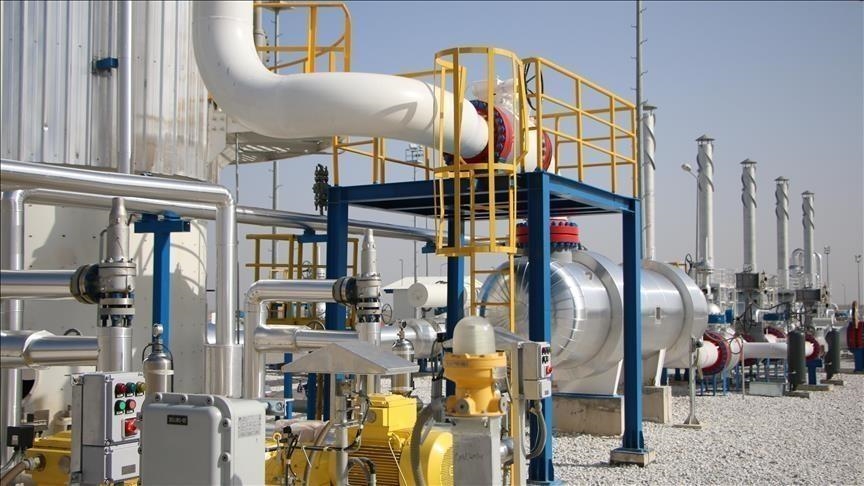

By Anadolu Agency
ANKARA
Liquefied Natural Gas (LNG) emerged as a lifeline last year when growing energy demand coupled with supply disruptions from the Russia-Ukraine war caused historical shifts in the global energy market.
In a recent report released by the International Gas Union (IGU), Li Yalan, president of the IGU, affirmed that “the market is still out of balance and the crisis is not yet over.”
The report acknowledges that LNG has been a key component of the energy transition for many years, and last year, with the onset of the Russia-Ukraine conflict at the end of February, its role increased by 6.8% to approximately 401.5 million tones (MT), up 25.4 MT from the previous year.
The Russia-Ukraine conflict, which caused a reduction in Russian gas pipeline deliveries to Europe, raised the EU’s demand for LNG, and amid the bloc’s search for new energy sources, new LNG suppliers emerged.
With Europe’s unexpected and urgent need to replace Russian piped gas with short-term LNG exports, along with forced gas demand destruction to ensure stock-filling ahead of the northern hemisphere winter, an uneven and unpredictable LNG market arose, resulting in soaring gas prices in a tight market.
Furthermore, following a global economic rebound from the lengthy COVID lockdowns, the energy crisis emerged.
To keep up with rising demand, Europe imported over 66% more LNG in 2022 at over 50.4 MT, offsetting the energy shortage emanating from Russia’s pipeline supply loss, according to the report.
The US mainly drove the growth in LNG exports last year at nearly 10.5 MT, or 15%, while Russia ranked second with 3.4 MT, or 11.6%, followed by Qatar with 3.1 MT, or 4%.
Australia held its title as the world’s largest LNG producer, exporting 80.9 MT in 2022 and increasing exports by 2.4%.
Asia Pacific was the largest LNG exporting region, with 136.6 MT exported in 2022, a 5.2 MT increase over 2021. The largest contributors to this growth were Australia, Malaysia, and Indonesia.
The Middle East was the second-largest exporting region with 96.5 MT of output in 2022, followed by North America at 87.5 MT.
Asia is largest LNG importing region in 2022
The largest importing region for LNG was Asia Pacific, which imported a total of 160.9 MT in 2022, a 4.6 MT increase compared to 2021. Japan was the largest importer at 73.6 MT, followed by China with 63.7 MT.
Europe was the second-largest importing region with 126.6 MT of imports in 2022, a 50.4 MT increase compared to 2021. The largest importer countries in the region were France, the UK and the Netherlands, with 25.6 MT, 19.1 MT and 12.4 MT of imports, respectively. Türkiye became the tenth largest LNG importer with 11.4 MT last year.
LNG volumes from the US accounted for 44% of Europe’s total LNG imports, while Europe accounted for 69% of total US LNG exports last year, representing a 148% increase compared to 2021 levels.
US leads new liquefaction capacity brought online in 2022
According to the report, a total of 19.9 million tones per annum (MTPA) of liquefaction capacity was brought online last year to reach a global total of 478.4 MTPA across 22 markets.
New liquefaction capacity in the US market accounted for 75% of the capacity increase, reaching a total of 88.1 MTPA. It was followed by Australia with 87.6 MTPA, and Qatar with 77.1 MTPA.
More than 80% of regasification capacity additions last year come from new terminals
Global regasification capacity reached 970.6 MTPA across 48 markets as of the end of April this year. In 2022, the highest capacity additions were in Europe, which saw an additional 14.5 MTPA of regasification, followed by Asia Pacific with 8.5 MTPA of new regasification, Asia with 6 MTPA, and Latin America with 2.2 MTPA.
Of the 31.2 MTPA regasification capacity additions in 2022, more than 80% came from new terminals. Nine new terminals were commissioned globally, with unprecedented growth in Europe.
More than 10 European countries, including Germany, the Netherlands, Finland, France, Croatia and Italy, have initiated the construction of new capacity since the Russia-Ukraine conflict broke out. This includes 26 projects with a combined regasification capacity of 104.5 MTPA. Of these, six have been commissioned, adding 25.5 MTPA to global capacity as of April 2023.
Floating terminals have become popular in Europe owing to redeployment abilities
There has been a notable trend in Europe towards floating regasification terminals given their ability for redeployment and speed to market compared to onshore terminals.
However, compared to floating-based terminals, offshore terminals can reduce exposure to risks from weather conditions, vessel performance and charter renewal.
As of the end of April 2023, there were 44 floating and offshore terminals worldwide with a total import capacity of 177.2 MTPA, accounting for around 18% of global regasification capacity. These terminals are located in various regions, including Asia, Europe, the Middle East, and the Americas.
In addition, 16 floating and offshore terminals are under construction, with a total regasification capacity of 58.3 MTPA, the majority of which are scheduled for completion this year.
We use cookies on our website to give you a better experience, improve performance, and for analytics. For more information, please see our Cookie Policy By clicking “Accept” you agree to our use of cookies.
Read More